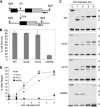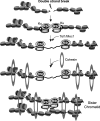RSC facilitates Rad59-dependent homologous recombination between sister chromatids by promoting cohesin loading at DNA double-strand breaks
- PMID: 21807899
- PMCID: PMC3187356
- DOI: 10.1128/MCB.01269-10
RSC facilitates Rad59-dependent homologous recombination between sister chromatids by promoting cohesin loading at DNA double-strand breaks
Abstract
Homologous recombination repairs DNA double-strand breaks by searching for, invading, and copying information from a homologous template, typically the homologous chromosome or sister chromatid. Tight wrapping of DNA around histone octamers, however, impedes access of repair proteins to DNA damage. To facilitate DNA repair, modifications of histones and energy-dependent remodeling of chromatin are required, but the precise mechanisms by which chromatin modification and remodeling enzymes contribute to homologous DNA repair are unknown. Here we have systematically assessed the role of budding yeast RSC (remodel structure of chromatin), an abundant, ATP-dependent chromatin-remodeling complex, in the cellular response to spontaneous and induced DNA damage. RSC physically interacts with the recombination protein Rad59 and functions in homologous recombination. Multiple recombination assays revealed that RSC is uniquely required for recombination between sister chromatids by virtue of its ability to recruit cohesin at DNA breaks and thereby promoting sister chromatid cohesion. This study provides molecular insights into how chromatin remodeling contributes to DNA repair and maintenance of chromatin fidelity in the face of DNA damage.
Figures










Comment in
-
Roles of RSC, Rad59, and cohesin in double-strand break repair.Mol Cell Biol. 2011 Oct;31(19):3921-3. doi: 10.1128/MCB.05974-11. Epub 2011 Aug 15. Mol Cell Biol. 2011. PMID: 21844225 Free PMC article. No abstract available.
Similar articles
-
Roles of RSC, Rad59, and cohesin in double-strand break repair.Mol Cell Biol. 2011 Oct;31(19):3921-3. doi: 10.1128/MCB.05974-11. Epub 2011 Aug 15. Mol Cell Biol. 2011. PMID: 21844225 Free PMC article. No abstract available.
-
Pds5 is required for homologue pairing and inhibits synapsis of sister chromatids during yeast meiosis.J Cell Biol. 2009 Sep 7;186(5):713-25. doi: 10.1083/jcb.200810107. J Cell Biol. 2009. PMID: 19736318 Free PMC article.
-
Cohesin regulates homology search during recombinational DNA repair.Nat Cell Biol. 2021 Nov;23(11):1176-1186. doi: 10.1038/s41556-021-00783-x. Epub 2021 Nov 8. Nat Cell Biol. 2021. PMID: 34750581
-
New insights into cohesin loading.Curr Genet. 2018 Feb;64(1):53-61. doi: 10.1007/s00294-017-0723-6. Epub 2017 Jun 19. Curr Genet. 2018. PMID: 28631016 Review.
-
Damage-induced reactivation of cohesin in postreplicative DNA repair.Bioessays. 2008 Jan;30(1):5-9. doi: 10.1002/bies.20691. Bioessays. 2008. PMID: 18081005 Free PMC article. Review.
Cited by
-
Cohesin protects genes against γH2AX Induced by DNA double-strand breaks.PLoS Genet. 2012 Jan;8(1):e1002460. doi: 10.1371/journal.pgen.1002460. Epub 2012 Jan 19. PLoS Genet. 2012. PMID: 22275873 Free PMC article.
-
Rad52/Rad59-dependent recombination as a means to rectify faulty Okazaki fragment processing.J Biol Chem. 2014 May 23;289(21):15064-79. doi: 10.1074/jbc.M114.548388. Epub 2014 Apr 7. J Biol Chem. 2014. PMID: 24711454 Free PMC article.
-
The Emerging Role of Cohesin in the DNA Damage Response.Genes (Basel). 2018 Nov 28;9(12):581. doi: 10.3390/genes9120581. Genes (Basel). 2018. PMID: 30487431 Free PMC article. Review.
-
DNA repair goes hip-hop: SMARCA and CHD chromatin remodellers join the break dance.Philos Trans R Soc Lond B Biol Sci. 2017 Oct 5;372(1731):20160285. doi: 10.1098/rstb.2016.0285. Philos Trans R Soc Lond B Biol Sci. 2017. PMID: 28847822 Free PMC article. Review.
-
The Saccharomyces cerevisiae chromatin remodeler Fun30 regulates DNA end resection and checkpoint deactivation.Mol Cell Biol. 2012 Nov;32(22):4727-40. doi: 10.1128/MCB.00566-12. Epub 2012 Sep 24. Mol Cell Biol. 2012. PMID: 23007155 Free PMC article.
References
-
- Bai Y., Symington L. S. 1996. A Rad52 homolog is required for RAD51-independent mitotic recombination in Saccharomyces cerevisiae. Genes Dev. 10:2025–2037 - PubMed
-
- Bao Y., Shen X. 2007. Chromatin remodeling in DNA double-strand break repair. Curr. Opin. Genet. Dev. 17:126–131 - PubMed
-
- Cairns B. R., et al. 1996. RSC, an essential, abundant chromatin-remodeling complex. Cell 87:1249–1260 - PubMed
-
- Cairns B. R., et al. 1999. Two functionally distinct forms of the RSC nucleosome-remodeling complex, containing essential AT hook, BAH, and bromodomains. Mol. Cell 4:715–723 - PubMed
Publication types
MeSH terms
Substances
Grants and funding
LinkOut - more resources
Full Text Sources
Molecular Biology Databases
